What Is the Amazon Referral Fee
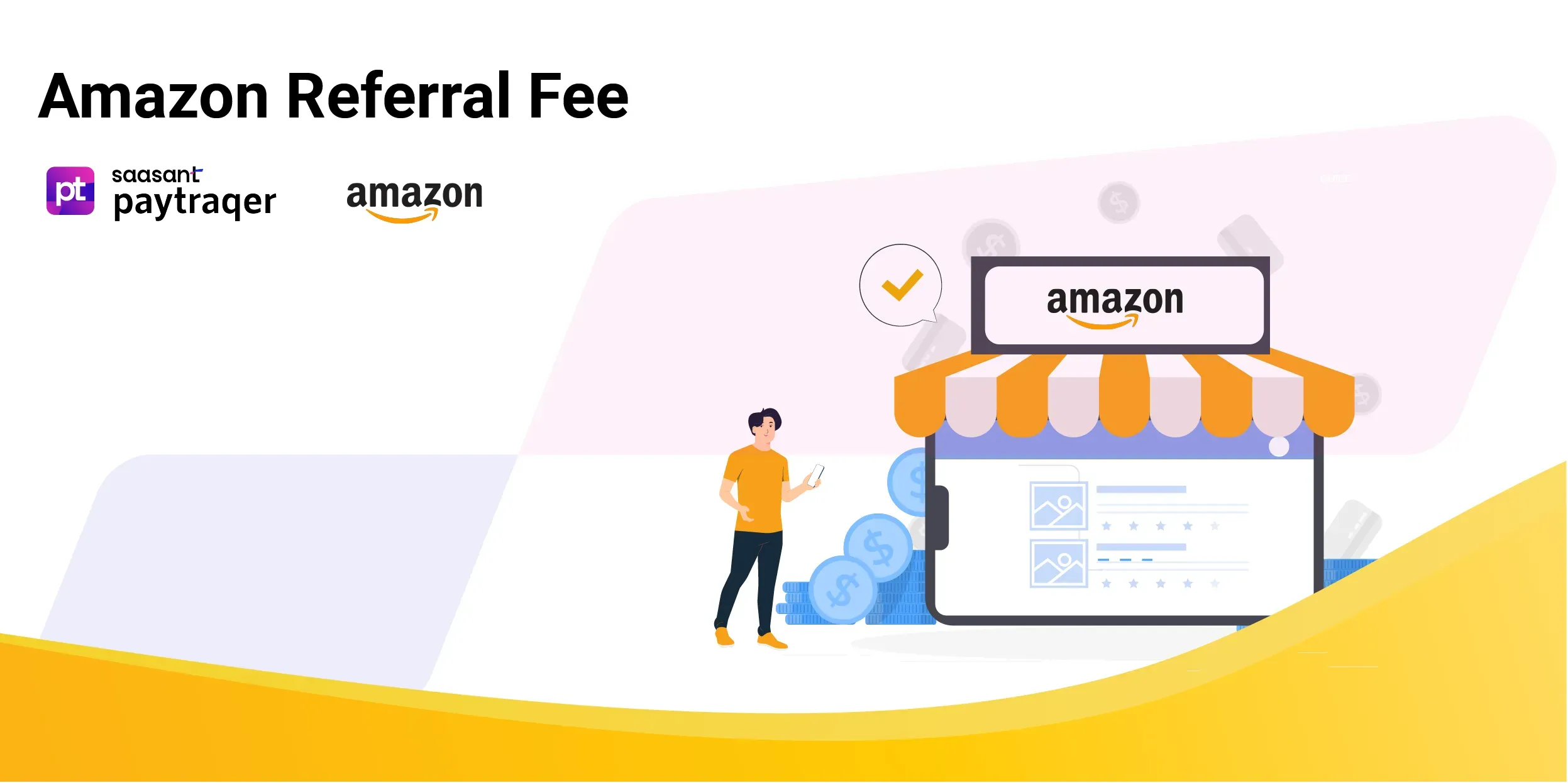
What Is Amazon’s Role in E-commerce?
Amazon has become a dominant force in the E-commerce world, offering customers access to millions of products and sellers access to a vast customer base. Amazon is undoubtedly the world's largest online retailer and has significantly shaped the E-commerce industry.
As of February 2024, Amazon has a market value of $1.814 Trillion, and it has redefined the way people shop, making online shopping a convenient and cost-effective option. Another significant aspect of Amazon's role in E-commerce is its impact on small businesses. However, selling on Amazon comes with fees, including the referral fee. This article will explore the Amazon referral fee, its calculation, and its impact on sellers.
Amazon offers a marketplace for millions of sellers to connect with customers and sell their products online. While Amazon provides sellers with a platform to sell their products, it also charges fees for its services. One of these fees is the Amazon referral fee.
So, what is Amazon's referral fee? Simply put, it is the fee Amazon charges its sellers for every item sold on its platform. This fee is calculated as a percentage of the sale price and varies depending on the product category. The referral fee covers promoting, advertising, and facilitating product sales.
Amazon referral fees are applied to most products sold on the platform, with a few exceptions. The referral fee is a vital source of revenue for Amazon, as it helps the company cover its operational costs and invest in new services. For sellers, the referral fee is a cost they must factor into their pricing strategy. If they account for this fee, they can avoid losing money on their sales.
The referral fee varies depending on the category of the product being sold. For example, Amazon charges a referral fee of 15% on most types of products, such as electronics, home and garden, and pet supplies. However, for some categories, such as Amazon devices, the fee may range from 6% to 7%. On the other hand, the referral fee may be as high as 20% for specific categories like jewelry and watches.
It's important to note that the referral fee is one of many sellers must pay while selling on Amazon. They may also be required to pay a monthly subscription fee, shipping and fulfillment fees, and other charges depending on the services they use.
Contents
What Is Amazon’s Role in E-commerce?
Exceptional Product Categories and Their Related Referral Fees
How to Calculate the Amazon Referral Fee?
Determine the Product Category
Determine the Sales Price
Determine the Referral Fee Percentage
Calculate the Referral Fee
What Is the Amazon Referral Fee Rate for Different Product Categories?
What Is the Difference between Amazon Referral Fees and Other E-commerce Platform Fees?
How Do Amazon Referral Fees Affect Seller Profits?
What Is the Role of Referral Fee in Amazon’s Revenue Model?
How Can You Manage the Referral Fees and Maximize Your Profit?
Wrap Up
Exceptional Product Categories and Their Related Referral Fees
Amazon has some special product categories that have varied referral fees than the standard referral fee of 15% for most categories. These special categories have either lower or higher referral fees. Here are some examples.
Amazon Devices: Amazon charges a referral fee of 6% to 45% for Amazon devices such as Kindle, Echo, Fire TV, and Fire Tablets. The fee varies depending on the device’s price and category.
Personal Computers: Amazon charges a referral fee of 6% for personal computers, including laptops, desktops, and tablets.
Video Games: Amazon charges a referral fee of 15% for most video games, but for consoles, it charges a referral fee of 8%.
Jewelry: Amazon charges a referral fee of 20% for the jewelry product category.
Watches: Amazon charges a referral fee of 16% for watches.
Furniture and Decor: Amazon charges a referral fee of 15% for most furniture and decor items.
Musical Instruments: Amazon charges a referral fee of 15% for most musical instruments, including guitars, drums, and keyboards.
Amazon sellers must know the different referral fees for special categories to ensure they are pricing their products appropriately and making a profit. They can use Amazon's fee calculator tool to determine the referral fee for their product based on category, price, and other factors.
How to Calculate the Amazon Referral Fee?
As a seller, it's essential to understand how to calculate the Amazon referral fee to ensure you're pricing your products correctly and yielding profits. Here's a step-by-step guide on how to calculate the Amazon referral fee.
Determine the Product Category
The first step in calculating the Amazon referral fee is determining the product category being sold. Amazon has different referral fee rates for different product categories, and knowing which type your product falls into is prominent.
Determine the Sales Price
The next step is to contemplate the sale price of the product. This is the price the customer pays for the product, excluding shipping or handling fees. The sale price is a crucial factor in determining the referral fee because the referral fee is calculated as a percentage of the sales price.
Determine the Referral Fee Percentage
Once you've determined the product category and sale price, you can use Amazon's fee schedule to determine the referral fee percentage for a specific type. Amazon charges a referral fee of 15% for most categories, but there are exceptions where the fee may be either lower or higher.
Calculate the Referral Fee
The final step is calculating the referral fee by multiplying the sale price by the referral fee percentage. For example, if the product's sale price is $100 and the referral fee percentage is 15%, the referral fee would be $15 (100*0.15).

It's important to note that there may be additional fees, such as the FBA fee, shipping fee, or storage fee, that sellers may need to factor in while determining the total cost of selling a product on Amazon.
Amazon provides a fee calculator tool to simplify calculating the Amazon referral fee. The tool considers the product strategy, sale price, and other factors to calculate the referral fee. It's recommended that sellers use the fee calculator to ensure precise and streamlined calculations.
By understanding how to calculate the Amazon referral fee, sellers can make informed decisions about their pricing strategy and maximize their profits by selling on the Amazon platform.
What Is the Amazon Referral Fee Rate for Different Product Categories?
As an Amazon seller, it's essential to understand the referral rates for different product categories. These referral fees vary widely, and knowing what to expect can help you make mindful decisions about pricing and which products to sell.
As mentioned, the Amazon referral fees are calculated as a percentage of the total sales price, excluding taxes and shipping costs. These fees cover Amazon's costs for promoting and advertising the product, facilitating the sale, and maintaining the platform. The following are some examples of referral rates for different product categories:
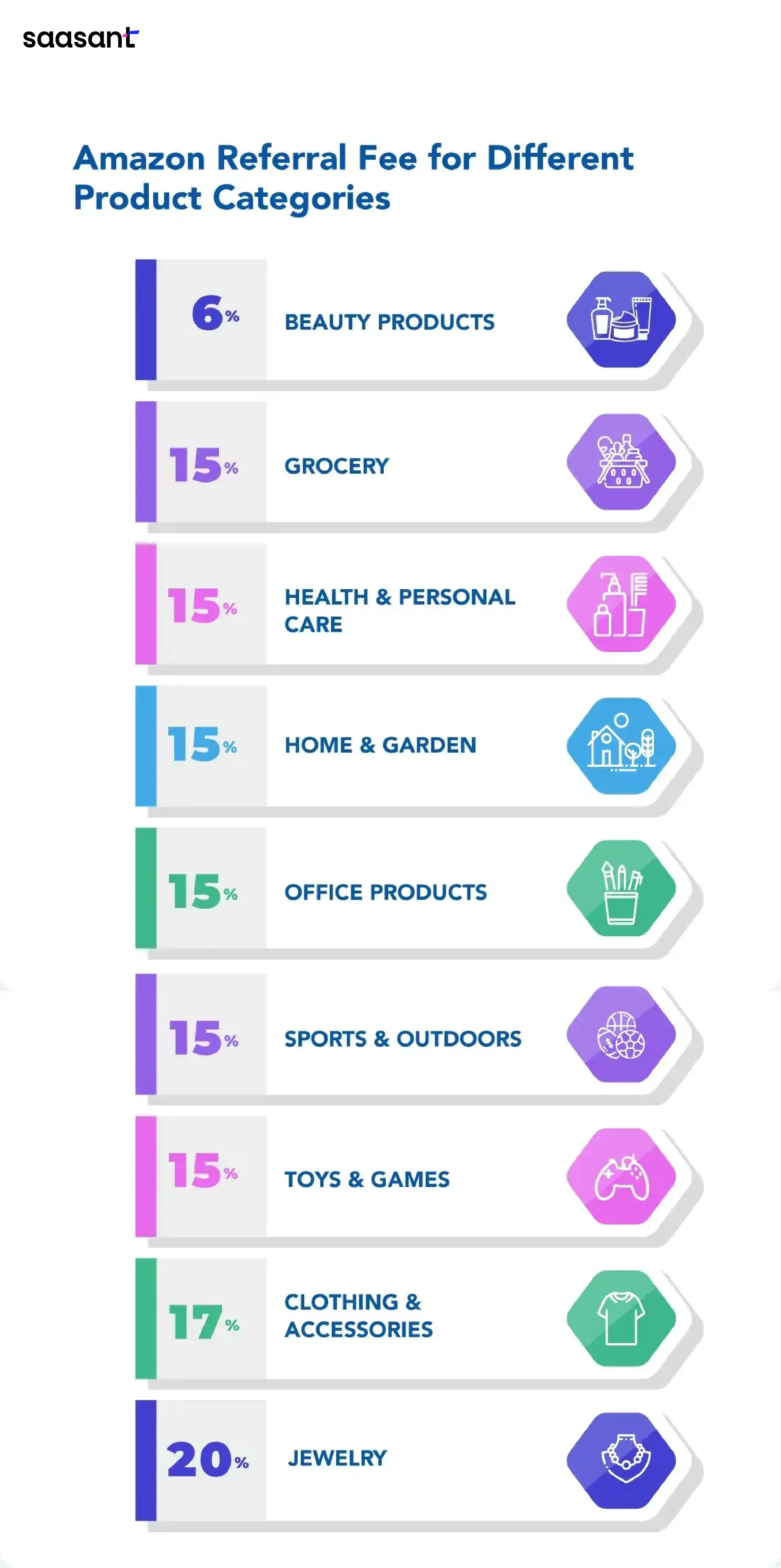
It's important to note that the referral fees can also vary depending on the item price. For items over $1,000, referral fees may be lower; for items under $1, referral fees may be higher.
It’s also worth noting that Amazon periodically updates its referral fee rates for different product categories, so it’s vital to check the current rates on Amazon’s website regularly. These rates can be found in Amazon’s Fee Schedule.
What Is the Difference between Amazon Referral Fees and Other E-commerce Platform Fees?
As an E-commerce seller, one of the most important factors to consider is the fees associated with selling on different platforms. Below is the comparison of Amazon referral fees to other E-commerce platforms.
Etsy Fees
eBay Fees
Walmart Marketplace Fees
Shopify Fees
Etsy Fees
Etsy is a popular platform for handmade and vintage products. Etsy charges a $0.20 listing fee for each item listed and a 5% transaction fee on the sale price, including shipping costs. Etsy also offers optional advertising services, such as promoted listings, which charge an additional fee.
eBay Fees
eBay is an auction-style platform that charges a final value fee based on the total amount of the sale, including shipping costs. The absolute value fee can vary based on the product category, ranging from 2.35% to 12%. eBay also charges an insertion fee for each listing, ranging from $0.10 to $2.00.
Walmart Marketplace Fees
Walmart Marketplace is a growing platform that charges a referral fee based on the product category, ranging from 6% to 20% of the total sale price, excluding taxes and shipping costs. Walmart also charges a subscription fee of $39.00 per month and a referral fee for each product sold.
Shopify Fees
Shopify is an E-commerce platform that allows sellers to create their online stores. Shopify charges a monthly subscription fee, ranging from $29 to $299 per month, depending on the plan. Shopify also charges a transaction fee of 2.9% + $0.30 per transaction for sellers using their payment gateway.
Optimize your E-commerce journey with PayTraQer; an application streamlining financial processes. Connect multiple payment processors and E-commerce platforms seamlessly to your accounting software, whether it's PayPal, Stripe, Square, Shopify, Amazon, eBay, or others. Choose automatic or manual data sync, customize transaction entries with personalized rules, and benefit from multi-currency support. Detect duplicate transactions for accuracy, and access comprehensive financial reports on a unified dashboard for insights into sales performance, revenue, and profitability. Manage your E-commerce finances effortlessly with PayTraQer, ensuring precision and maximizing your hard-earned revenue. Explore how PayTraQer can elevate your E-commerce efficiency today.
The difference between Amazon referral fees and other E-commerce platforms is tabulated below:
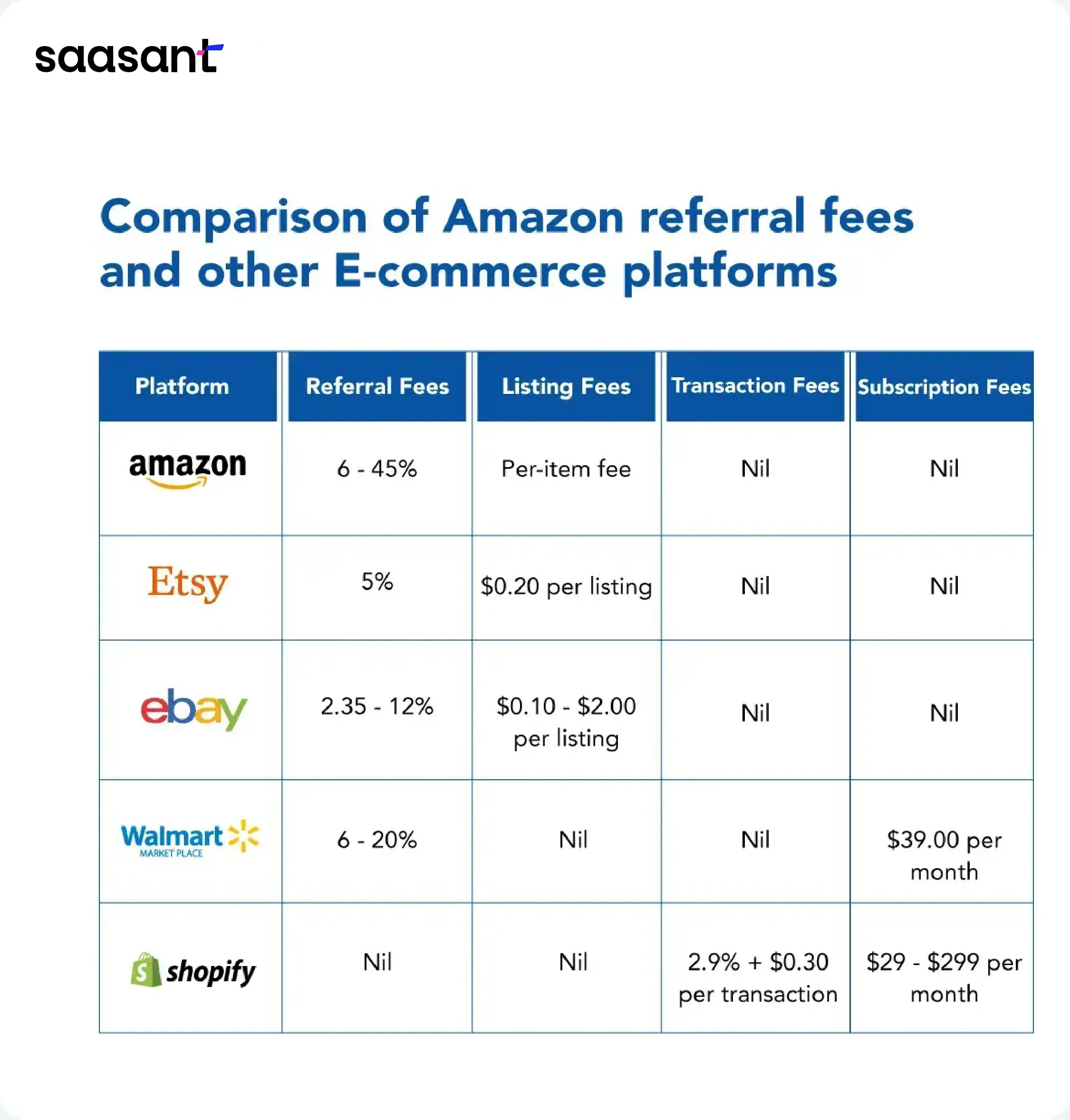
As you can see from the chart, each platform has a unique fee structure that can impact a seller's profit margins. Amazon has many referral fees but does not charge a listing or transaction fee. Etsy and eBay charge a transaction fee, while Walmart Marketplace charges a subscription fee. Shopify charges a transaction fee and a subscription fee.
Recognizing the fees associated with selling on different E-commerce platforms is critical for sellers. Each platform has a distinctive fee structure, and sellers should carefully consider these fees when choosing where to sell their products. By doing so, sellers can maximize their profit margins.
How Do Amazon Referral Fees Affect Seller Profits?
Amazon referral fees can significantly impact a seller's profit margins. Let's take a look at an example. Suppose you sell a product in the electronics category for $100, and the referral fee is 8%. In that case, you must pay Amazon $8 for each sale. If you sell 100 units of that product, your referral fee expenses will be $800, reducing your total revenue to $9,200.
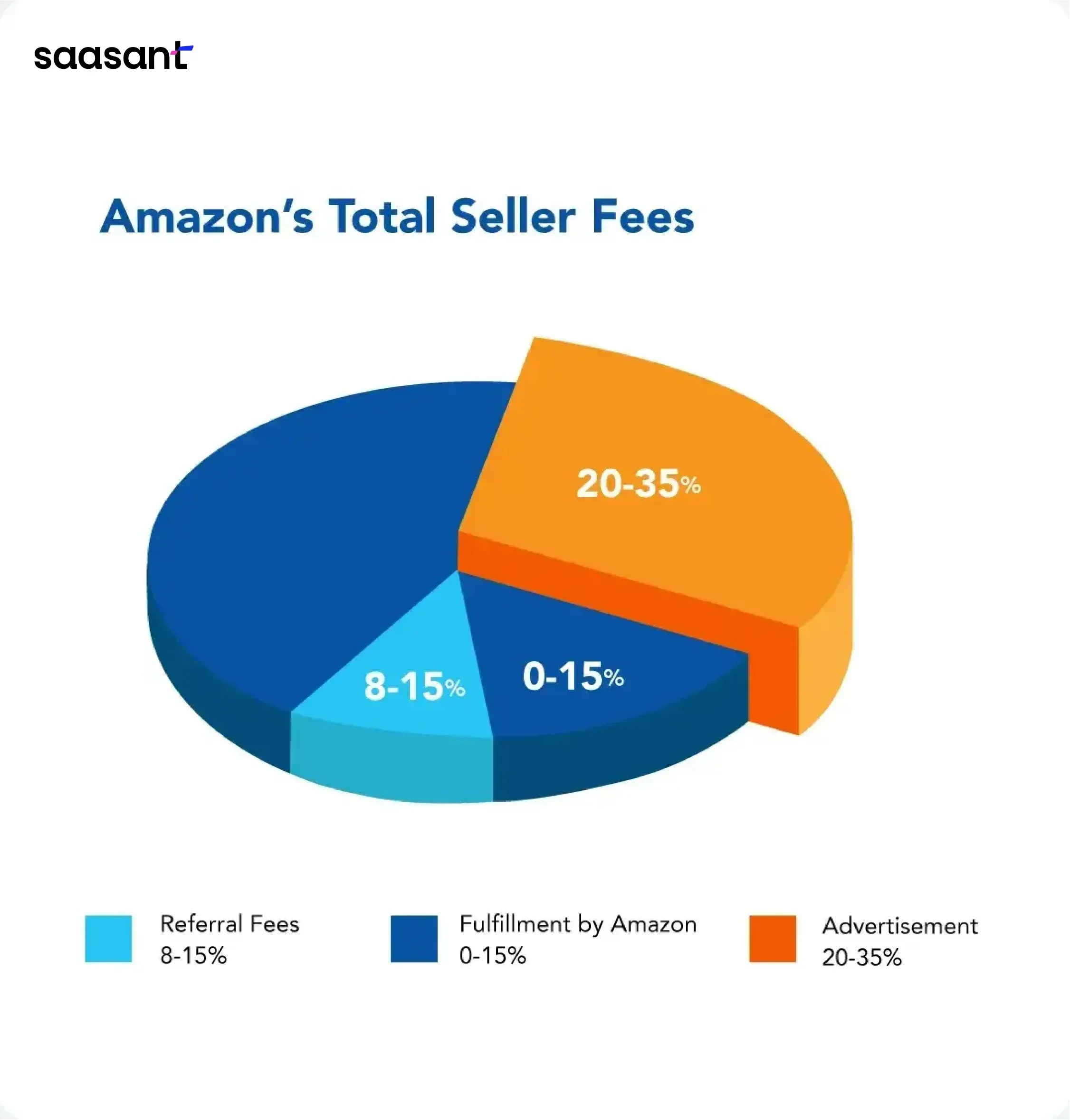
This example demonstrates how Amazon referral fees can affect a seller's profit margins, especially if the product's margin is already low. Moreover, Amazon referral fees have increased over the years. According to a report by Marketplace Pulse, Amazon is earning more than 50% of sellers' revenue, up from 40% in 2016. This referral fee increase can significantly impact a seller's profitability, especially for small businesses and sellers with low profit margins.
However, it's essential to note that Amazon provides sellers with a massive customer base and a robust platform to drive sales. While referral fees can cut a seller's profits, the benefits of selling on Amazon may outweigh the costs, depending on the seller's business goals and objectives.
What Is the Role of Referral Fee in Amazon’s Revenue Model?
In E-commerce, referral fees are crucial in driving revenue for online marketplaces such as Amazon. One of the primary reasons why referral fees are essential for Amazon is that they provide a steady income stream for the company.
According to Amazon’s 2022 annual report, the company generated $117.716 billion in third-party seller services revenue, which includes referral fees. This represents a significant portion of Amazon’s overall revenue, which was $513.983 billion in 2022.
Referral fees also incentivize sellers to list their products on Amazon. Amazon can attract many sellers to its platform by charging a commission on each scale. This, in turn, increases the selection of products available to Amazon's customers, which enhances the overall shopping experience.
Moreover, referral fees are an essential component of Amazon’s Flywheel Effect, a strategy that Amazon uses to drive growth and improve customer experience. The Flywheel Effect refers to the concept that Amazon’s various business segments - including third-party seller services and subscription services- feed into one another.
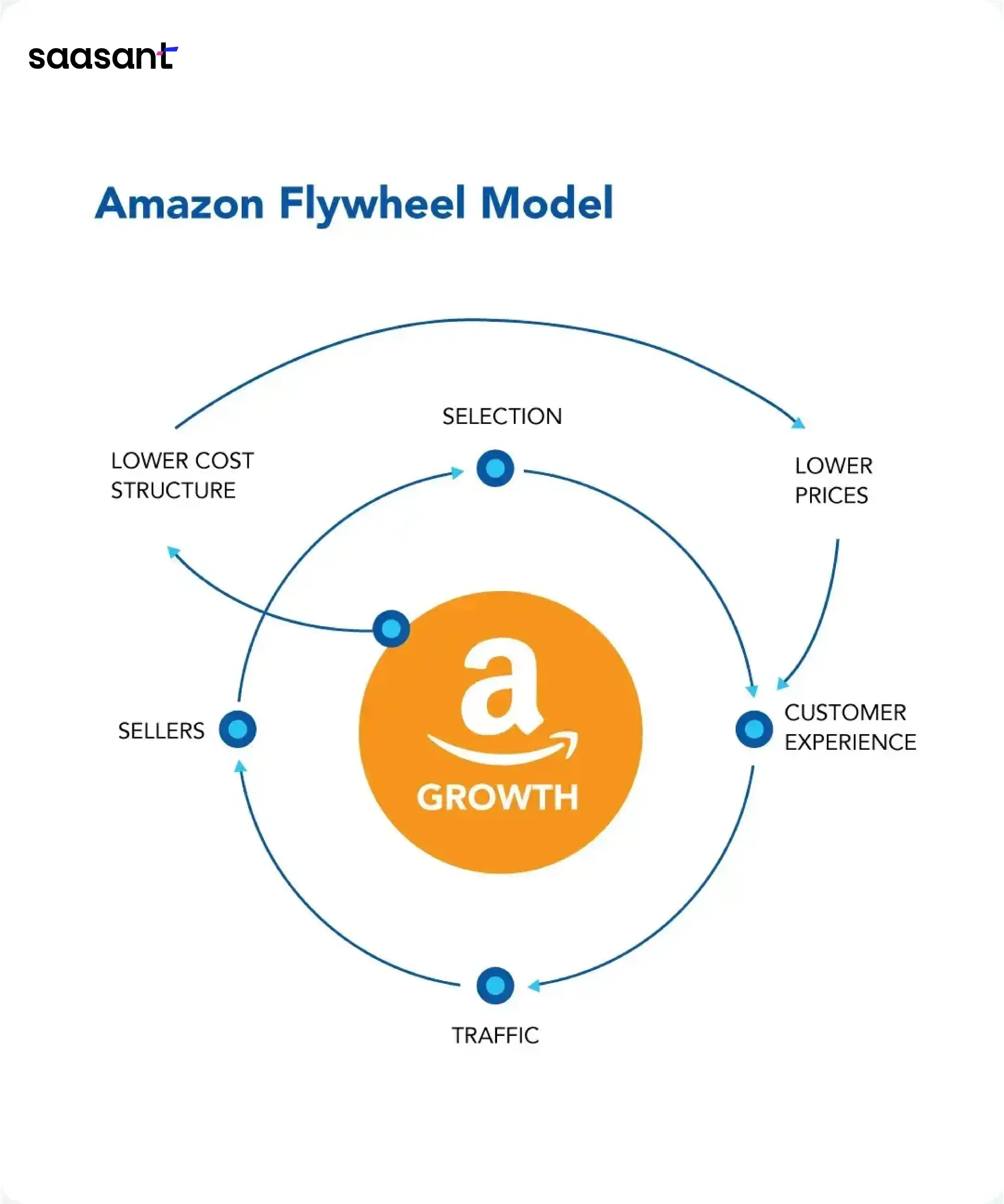
As more sellers list their products on Amazon and pay referral fees, Amazon can invest more in customer acquisition and retention through its subscription services and advertising products. This, in turn, attracts more customers to the platform, which leads to more sales and referral fees. A recent article by The Street reported that third-party seller service revenue accounted for 23%, a substantial portion of the company's overall revenue.
How Can You Manage the Referral Fees and Maximize Your Profit?
Amazon is an excellent platform for sellers to earn profits by selling their products to millions of customers. However, to use the platform, sellers must pay a referral fee to Amazon for every sale. We’ll now discuss managing the Amazon referral fee and pocket profit as an Amazon seller.
Understand the Amazon Referral Fee Structure
The first step in managing the Amazon referral fee is understanding its structure. Amazon has over 20 categories, each with a different referral fee percentage. Amazon also charges additional fees for optional services, such as fulfillment by Amazon (FBA).
Optimize Your Product Pricing
To earn a profit on Amazon, sellers must set their prices appropriately. To manage the referral fee, sellers should factor into their pricing strategy. For example, if the referral fee for a product is 15%, the seller should set the product's price accordingly to ensure they still make a profit after paying the referral fee.
Sellers should also monitor their competitor's prices and adjust their pricing strategy accordingly. It is essential to price products competitively while making a profit after paying the referral fee.
Use Amazon’s FBA Service
Fulfillment by Amazon (FBA) is an optional service that Amazon offers to sellers. With FBA, sellers can store their products in Amazon’s warehouses, and Amazon takes care of the packaging, shipping, and customer service.
While FBA comes with additional fees, it can help sellers save time and money on packaging, shipping, and customer service. Moreover, Amazon rewards sellers who use FBA by giving them access to Amazon Prime customers and higher visibility in search results.
Use Amazon’s Advertising Services
Amazon offers several advertising services to help sellers promote their products on the platform. These services include sponsored products, sponsored brands, and sponsored displays.
These services can increase a product's visibility and improve its purchase chance. However, they also come with additional fees, so sellers need to factor them into their pricing strategy to ensure they still make a profit.
Monitor Your Sales and Adjust Your Strategy
Sellers should continuously monitor their sales and adjust their strategy accordingly. Sellers should track their sales, profits, and expenses to ensure they profit on Amazon.
If a product is not selling well, sellers should adjust their pricing and advertising strategies or consider discontinuing it. On the other hand, if a product is selling well, sellers should consider increasing its price or investing more in advertising to promote it further.
Wrap Up
Finally, the Amazon referral fee is essential to selling on Amazon. Understanding how referral fees are calculated and how they impact profit margins is critical for sellers. By choosing the right product category, pricing strategy and factoring referral fees into their overall costs, sellers can minimize the impact of referral fees and still profit from Amazon.
Amazon provides sellers with a vast customer base and acts as a robust platform to drive sales. By performing meticulous research on the referral fees for each product category, setting competitive prices, and leveraging Amazon's FBA program, sellers can maximize their profits on Amazon.
If you want to know more about Amazon selling without inventory, read how to sell on Amazon without inventory.
FAQs
What is a referral fee on Amazon, and how is it calculated?
A referral fee on Amazon is the cost associated with selling a product on the platform. It is a percentage of the item's sale price and varies by product category.
What is Fulfillment by Amazon (FBA), and how does it affect sellers?
FBA is a service where Amazon handles storage, packing, and shipping of a seller's products. Sellers using FBA may incur additional fees, including fulfillment and storage fees.
Can you explain the Amazon fee structure for sellers?
Amazon charges sellers various fees, including referral, fulfillment, and storage fees. The structure is complex and may vary based on the type of seller account and the product category.
What are the typical fees associated with selling on Amazon as of 2024?
As of 2024, Amazon fees include referral fees, FBA fees, storage fees, and potentially other charges depending on the seller's account type and the products being sold.
How does Amazon calculate the referral fee percentage, and are there minimum referral fees?
The referral fee percentage is based on the product category, and there may be a minimum referral fee per item. Sellers should check the specific category rates on Amazon's fee schedule.
What is the significance of the long-term storage fee for sellers using FBA?
Long-term storage fees apply to items stored in Amazon's fulfillment centers for an extended period. Sellers should manage inventory effectively to avoid incurring additional charges.
How does the inbound placement service fee impact sellers using FBA?
The inbound placement service fee is charged for FBA sellers who opt for Amazon to place their products in specific locations. Sellers should understand the implications of this fee on their supply chain.